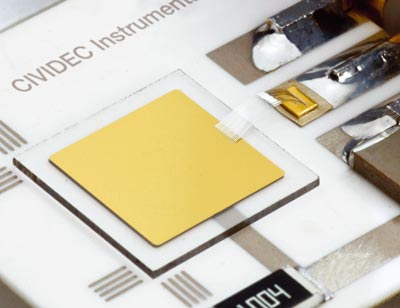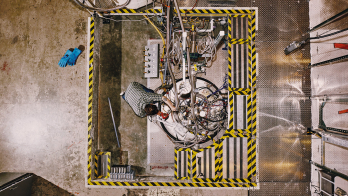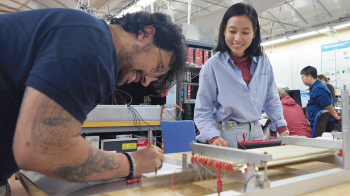How research on diamond detectors led to a hi-tech company in Austria.

Image credit: Hikade.
Stories about how technology giants like Hewlett Packard started in a wooden garage appeal to everyone. Private venture capital is constantly searching for the right spin-off or newly founded company to emulate such success stories. Likewise, politicians try to create the right atmosphere for technology-driven projects in the hope of creating jobs and driving economic growth. Institutes like CERN are expected to stimulate this process of rejuvenation by generating new ideas and supporting a high turnover of students and staff to spread those ideas. Most institutes duly hold open days, run technology fairs, compile lists of their in-house technologies, apply for patents and support technology transfer in general.
However, much of technology transfer is possibly more subtle and incremental in nature. It is as if ideas have a life of their own and are working away steadily for years, often through seemingly unconnected events, while the different elements are being assembled. One example that has weaved its way through the activities of CERN and its member states concerns a particle detector using artificial diamond, which is finding an expanding role in the LHC experiments and machine, as well as in other applications.
Following the tracks
The advanced-technology landscape is constantly evolving and there is no absolute beginning or end to any particular development. The action moves from one field to another and is driven forward by different goals at different times. Here, the quest to produce artificial diamond provides an appropriate starting point. This was akin to the search for the philosopher’s stone – recorded efforts date back a hundred years – but the first person to succeed was William G Eversole of the Union Carbide Corporation in the US in 1952. Contrary to intuition and the bulk of earlier work, he used a low-pressure process called chemical vapour deposition (CVD).
The CVD technology made it possible to manufacture diamond coatings, films and precise shapes. Prior to this time, natural diamonds had been demonstrated as UV detectors in the 1920s and as ionizing radiation detectors in the 1940s. The advent of CVD diamond removed limitations arising from size, shape and uncertainty in material characteristics and provided a rich potential for the development of sophisticated particle detectors.
The transition from fixed-target physics to colliding-beam physics during the 1970s stimulated a tremendous growth in the technology of particle detectors, and the requirements for speed and radiation hardness increased with each new collider project. In 1989 the DIAMAS collaboration of the Superconducting Super Collider (SSC) project in the US was the first to propose diamond for its particle trackers. With the closure of the SSC the focus moved to CERN, where the RD42 collaboration for the Development of Diamond Tracking Detectors for High Luminosity Experiments at the LHC was founded in 1994. This collaboration looked into CVD diamond technologies under the leadership of Peter Weilhammer of CERN, Harris Kagan of Ohio State University (and formerly of the DIAMAS collaboration) and William Trischuk, who was a founding member of RD42 and co-spokesperson in the early days.
One important activity in this group was the development of a beam condition monitor (BCM) for ATLAS, under the project leadership of Marko Mikuz. In fact, the first diamond BCM had been proposed and constructed some time earlier by Patricia Burchat of SLAC and Harris Kagan of the BaBar experiment at SLAC. The CMS, ALICE and LHCb experiments quickly followed the lead from ATLAS and installed diamond beam monitors.
Just before RD42 got going, in 1993 Erich Griesmayer, a postdoc working for the AUSTRON study in CERN, nurtured the idea of building a gigahertz particle counter for medical applications and wrote a proposal for its use in hadron therapy. (AUSTRON was an initiative in technology transfer funded by the Austrian government and hosted by CERN to lend its expertise in machine design. It later metamorphosed into MedAustron, which was recently funded for construction in Wiener Neustadt, Austria, but that is another story.) At that time, Griesmayer used silicon for his base calculations, although the material was too slow for what he had in mind.

In 1995, he returned to Austria to head the Department of Electrical Engineering of the Technische Fachhochschule in Wiener Neustadt and later its spin-off company FOTEC. There he pursued his ideas for a counter capable of resolving 109 particles a second, still with hadron therapy in mind. Meanwhile, a fellow postdoc, Heinz Pernegger, was working at MIT in the Laboratory for Nuclear Science for the PHOBOS collaboration, building a silicon detector for the Relativistic Heavy Ion Collider at Brookhaven. Griesmayer and Pernegger found that they had a common interest and Griesmayer and his engineer Helmut Frais-Kölbl built the calibration electronics for PHOBOS. This was the start of a long and fruitful collaboration that continued within the RD42 collaboration. In particular, the pre-amplifiers for the ATLAS BCM were built for CERN by FOTEC.
This was already a successful spin-off story for Austria and CERN, demonstrating how CERN could stimulate hi-tech projects in member states, but history was to be made when the Wiener Neustadt Technische Fachhochschule became a full member of the ATLAS collaboration, supplying electronic components for the readout system of the new diamond BCM. This was an unprecedented move and an inspiration to educational institutions across Europe.
Diamond benefits
Compared with silicon, diamond produces a lower linear density of electron-hole pairs along the incident particle track, but this is more than balanced by the positive effects of much higher electron and hole mobilities and a quasi-zero noise contribution from the diamond (see box). The leading edge of a single-particle pulse can be resolved in tens of picoseconds and individual pulses can be resolved on a nanosecond scale. Diamond is also an extraordinary material for radiation resistance. This is not only from the point of view of damage; diamond also responds linearly to the incident flux and its range is limited by the attached electronics rather than the material of the detector. According to the application, a diamond detector can be configured as a particle-counting ionization chamber or an energy-measuring calorimeter.
The potential of the diamond detector was clear to Griesmayer, who conducted many tests on prototypes with different particles and particle energies at accelerators in Europe and the US. Eventually, he founded his own company, CIVIDEC Instrumentation GmbH, in December 2009, creating a second-generation spin-off. The company now produces beam-monitoring systems based on diamond detectors with ultra-fast, low-noise electronics. It also specializes in the R&D aspects of tailoring the systems to particular problems. CIVIDEC recently collaborated with CERN to instrument the LHC machine with diamond beam-loss monitors.







